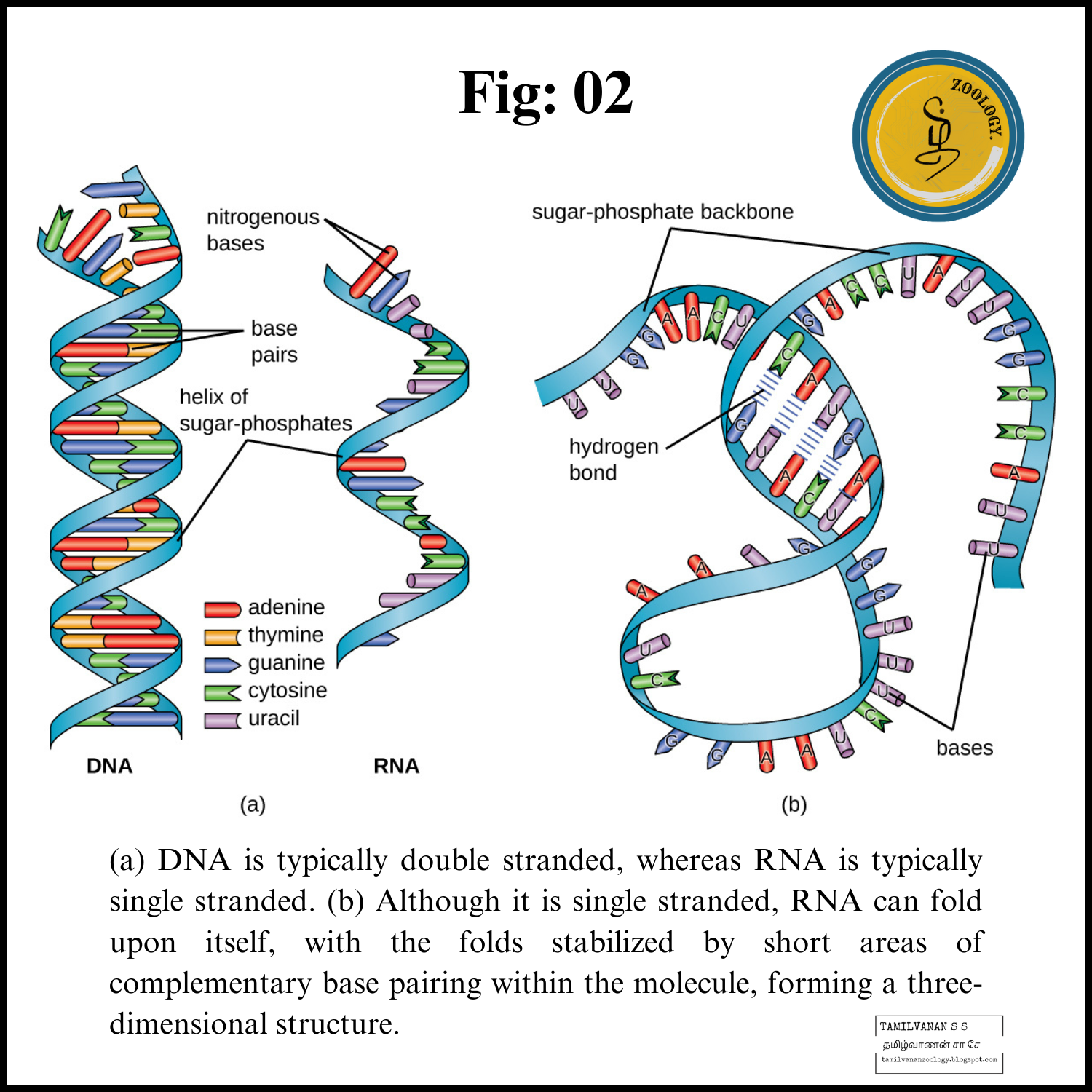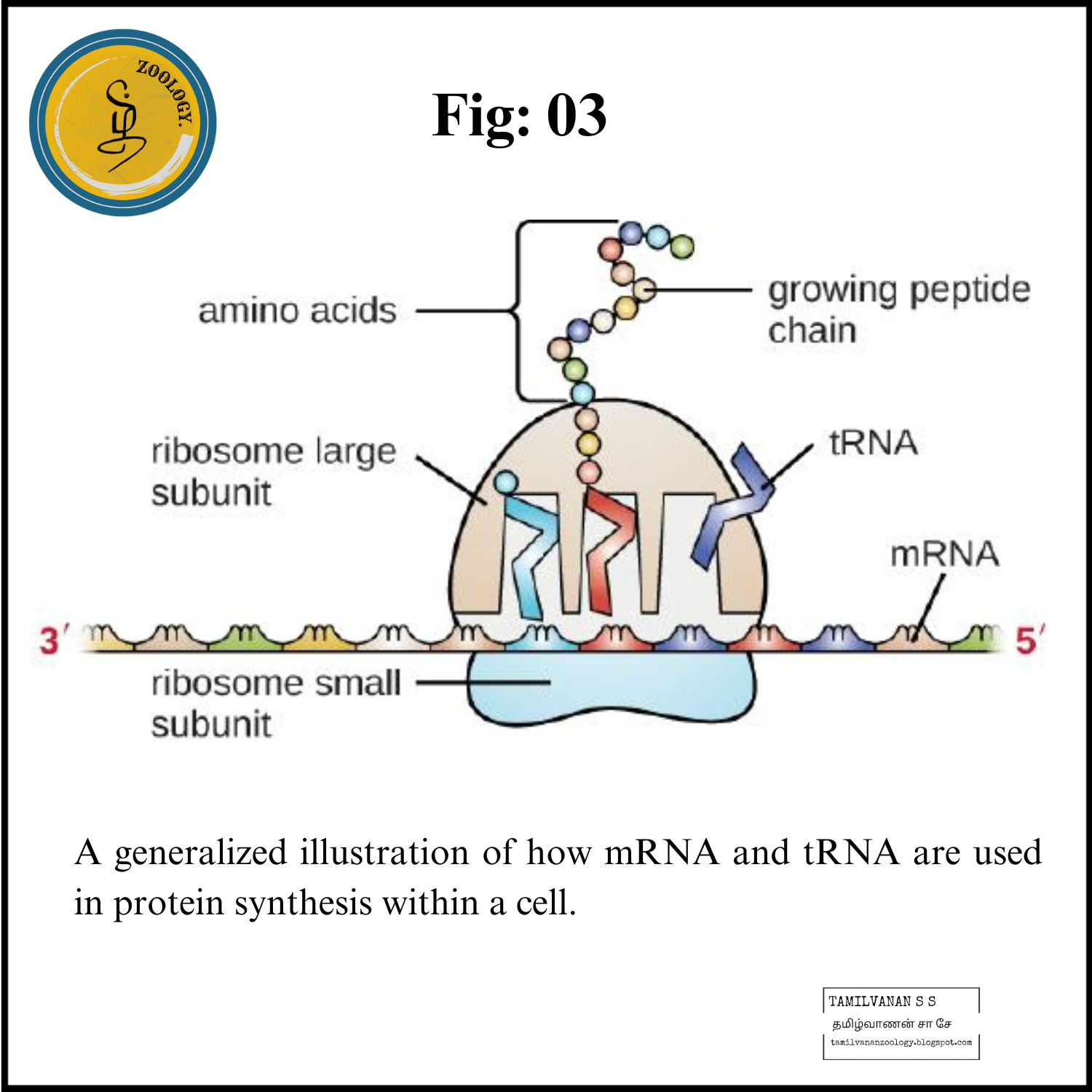Introduction
Structurally speaking, ribonucleic acid (RNA), is quite similar to DNA. However, whereas DNA molecules are typically long and double stranded, RNA molecules are much shorter and are typically single stranded. RNA molecules perform a variety of roles in the cell but are mainly involved in the process of protein synthesis (translation) and its regulation.
RNA Structure
RNA is typically single stranded and is made of ribonucleotides that are linked by phosphodiester bonds. A ribonucleotide in the RNA chain contains ribose (the pentose sugar), one of the four nitrogenous bases (A, U, G, and C), and a phosphate group. The subtle structural difference between the sugars gives DNA added stability, making DNA more suitable for storage of genetic information, whereas the relative instability of RNA makes it more suitable for its more short-term functions.
The RNA-specific pyrimidine
uracil forms a complementary base pair with adenine and is used instead of the thymine used in DNA. Even though RNA is single stranded, most types of RNA molecules show extensive intramolecular base pairing between complementary sequences within the RNA strand, creating a predictable three-dimensional structure essential for their function.
Functions of RNA in Protein Synthesis
Cells access the information stored in DNA by creating RNA to direct the synthesis of proteins through the process of translation. Proteins within a cell have many functions, including building cellular structures and serving as enzyme catalysts for cellular chemical reactions that give cells their specific characteristics.
The three main types of RNA directly involved in protein synthesis are messenger RNA (mRNA), ribosomal RNA (rRNA), and transfer RNA (tRNA). In 1961, French scientists François Jacob and Jacques Monod hypothesized the existence of an intermediary between DNA and its protein products, which they called messenger RNA.
Evidence supporting their hypothesis was gathered soon afterwards showing that information from DNA is transmitted to the ribosome for protein synthesis using mRNA. If DNA serves as the complete library of cellular information, mRNA serves as a photocopy of specific information needed at a particular point in time that serves as the instructions to make a protein.
The mRNA carries the message from the DNA, which controls all of the cellular activities in a cell. If a cell requires a certain protein to be synthesized, the gene for this product is “turned on” and the mRNA is synthesized through the process of transcription (see RNA Transcription).
The mRNA then interacts with ribosomes and other cellular machinery to direct the synthesis of the protein it encodes during the process of translation (see Protein Synthesis). mRNA is relatively unstable and short-lived in the cell, especially in prokaryotic cells, ensuring that proteins are only made when needed.
rRNA and tRNA are stable types of RNA. In prokaryotes and eukaryotes, tRNA and rRNA are encoded in the DNA, then copied into long RNA molecules that are cut to release smaller fragments containing the individual mature RNA species.
In eukaryotes, synthesis, cutting, and assembly of rRNA into ribosomes takes place in the nucleolus region of the nucleus, but these activities occur in the cytoplasm of prokaryotes. Neither of these types of RNA carries instructions to direct the synthesis of a polypeptide, but they play other important roles in protein synthesis.
Ribosomes are composed of rRNA and protein. As its name suggests, rRNA is a major constituent of ribosomes, composing up to about 60% of the ribosome by mass and providing the location where the mRNA binds.
The rRNA ensures the proper alignment of the mRNA, tRNA, and the ribosomes; the rRNA of the ribosome also has an enzymatic activity (peptidyl transferase) and catalyzes the formation of the peptide bonds between two aligned amino acids during protein synthesis.
Although rRNA had long been thought to serve primarily a structural role, its catalytic role within the ribosome was proven in 2000.2 Scientists in the laboratories of Thomas Steitz (1940–) and Peter Moore(1939–) at Yale University were able to crystallize the ribosome structure from Haloarcula marismortui, a halophilic archaeon isolated from the Dead Sea.
Because of the importance of this work, Steitz shared the 2009 Nobel Prize in Chemistry with other scientists who made significant contributions to the understanding of ribosome structure.
Transfer RNA is the third main type of RNA and one of the smallest, usually only 70–90 nucleotides long.
It carries the correct amino acid to the site of protein synthesis in the ribosome. It is the base pairing between the tRNA and mRNA that allows for the correct amino acid to be inserted in the polypeptide chain being synthesized.
Any mutations in the tRNA or rRNA can result in global problems for the cell because both are necessary for proper protein synthesis.
Types of RNA
In both prokaryotes and eukaryotes, there are three main types of RNA – messenger RNA (mRNA), ribosomal RNA (rRNA), and transfer RNA (tRNA). These 3 types of RNA are discussed below.
Messenger RNA (mRNA)
mRNA accounts for just 5% of the total RNA in the cell. mRNA is the most heterogeneous of the 3 types of RNA in terms of both base sequence and size. It carries complementary genetic code copied, from DNA during transcription, in the form of triplets of nucleotides called codons.
Each codon specifies a particular amino acid, though one amino acid may be coded for by many different codons. Although there are 64 possible codons or triplet bases in the genetic code, only 20 of them represent amino acids. There are also 3 stop codons, which indicate that ribosomes should cease protein generation by translation.
As part of post-transcriptional processing in eukaryotes, the 5’ end of mRNA is capped with a guanosine triphosphate nucleotide, which helps in mRNA recognition during translation or protein synthesis. Similarly, the 3’ end of an mRNA has a poly-A tail or multiple adenylate residues added to it, which prevents enzymatic degradation of mRNA. Both the 5’ and 3’ end of an mRNA imparts stability to the mRNA.
Ribosomal RNA (rRNA)
rRNAs are found in the ribosomes and account for 80% of the total RNA present in the cell. Ribosomes are composed of a large subunit called the 50S and a small subunit called the 30S, each of which is made up of its own specific rRNA molecules. Different rRNAs present in the ribosomes include small rRNAs and large rRNAs, which belong to the small and large subunits of the ribosome, respectively.
rRNAs combine with proteins and enzymes in the cytoplasm to form ribosomes, which act as the site of protein synthesis. These complex structures travel along the mRNA molecule during translation and facilitate the assembly of amino acids to form a polypeptide chain. They interact with tRNAs and other molecules that are crucial to protein synthesis.
In bacteria, the small and large rRNAs contain about 1500 and 3000 nucleotides, respectively, whereas in humans, they have about 1800 and 5000 nucleotides, respectively. However, the structure and function of ribosomes is largely similar across all species.
Transfer RNA (tRNA)
tRNA is the smallest of the 3 types of RNA, possessing around 75-95 nucleotides. tRNAs are an essential component of translation, where their main function is the transfer of amino acids during protein synthesis. Therefore, they are called transfer RNAs.
Each of the 20 amino acids has a specific tRNA that binds with it and transfers it to the growing polypeptide chain. tRNAs also act as adapters in the translation of the genetic sequence of mRNA into proteins. Thus, they are also called adapter molecules.
tRNAs have a cloverleaf structure which is stabilized by strong hydrogen bonds between the nucleotides. They normally contain some unusual bases in addition to the usual 4, which are formed by methylation of the usual bases. Methyl guanine and methylcytosine are two examples of methylated bases.
Other types of RNA
Beyond the primary role of RNA in protein synthesis, several varieties of RNA exist that are involved in post-transcriptional modification, DNA replication, and gene regulation. Some forms of RNA are only found in particular forms of life, such as in eukaryotes or bacteria.
Small nuclear RNA (snRNA)
snRNA is involved in the processing of pre-messenger RNA (pre-mRNA) into mature mRNA. They are very short, with an average length of only 150 nucleotides.
Regulatory RNAs
A number of types of RNA are involved in regulation of gene expression, including micro RNA (miRNA), small interfering RNA (siRNA) and antisense RNA (aRNA).
miRNA (21-22 nt) is found in eukaryotes, and acts through RNA interference (RNAi). miRNA can break down mRNA that it is complementary to, with the aid of enzymes. This can block the mRNA from being translated, or accelerate its degradation.
siRNA (20-25 nt) are often produced by breakdown of viral RNA, though there are also endogenous sources of siRNAs. They act similarly to miRNA. An mRNA may contain regulatory elements itself, such as riboswitches, in the 5' untranslated region or 3' untranslated region; these cis-regulatory elements regulate the activity of that mRNA.
Transfer-messenger RNA (tmRNA)
Found in many bacteria and plastids. tmRNA tag the proteins encoded by mRNAs that lack stop codons for degradation, and prevents the ribosome from stalling due to the missing stop codon.
Ribozymes (RNA enzymes)
RNAs are now known to adopt complex tertiary structures and act as biological catalysts. Such RNA enzymes are known as ribozymes, and they exhibit many of the features of a classical enzyme, such as an active site, a binding site for a substrate and a binding site for a cofactor, such as a metal ion.
One of the first ribozymes to be discovered was RNase P, a ribonuclease that is involved in generating tRNA molecules from larger, precursor RNAs. RNase P is composed of both RNA and protein; however, the RNA moiety alone is the catalyst.
Double-stranded RNA (dsRNA)
This type of RNA has two strands bound together, as with double-stranded DNA. dsRNA forms the genetic material of some viruses.
RNA as Hereditary Information
Although RNA does not serve as the hereditary information in most cells, RNA does hold this function for many viruses that do not contain
DNA. Thus, RNA clearly does have the additional capacity to serve as genetic information. Although RNA is typically single stranded within cells, there is significant diversity in viruses. Rhinoviruses, which cause the common cold; influenza viruses; and the Ebola virus are single-stranded RNA viruses. Rotaviruses, which cause severe gastroenteritis in children and other immunocompromised individuals, are examples of double-stranded RNA viruses. Because double-stranded RNA is uncommon in eukaryotic cells, its presence serves as an indicator of viral infection. The implications for a virus having an RNA genome instead of a DNA genome are discussed in more detail in Viruses.
Summary
Ribonucleic acid (RNA) is typically single stranded and contains ribose as its pentose sugar and the pyrimidine uracil instead of thymine. An RNA strand can undergo significant intramolecular base pairing to take on a three-dimensional structure.
There are three main types of RNA, all involved in protein synthesis.
Messenger RNA (mRNA) serves as the intermediary between DNA and the synthesis of protein products during translation.
Ribosomal RNA (rRNA) is a type of stable RNA that is a major constituent of ribosomes. It ensures the proper alignment of the mRNA and the ribosomes during protein synthesis and catalyzes the formation of the peptide bonds between two aligned amino acids during protein synthesis.
Transfer RNA (tRNA) is a small type of stable RNA that carries an amino acid to the corresponding site of protein synthesis in the ribosome. It is the base pairing between the tRNA and mRNA that allows for the correct amino acid to be inserted in the polypeptide chain being synthesized.
Although RNA is not used for long-term genetic information in cells, many viruses do use RNA as their genetic material.










